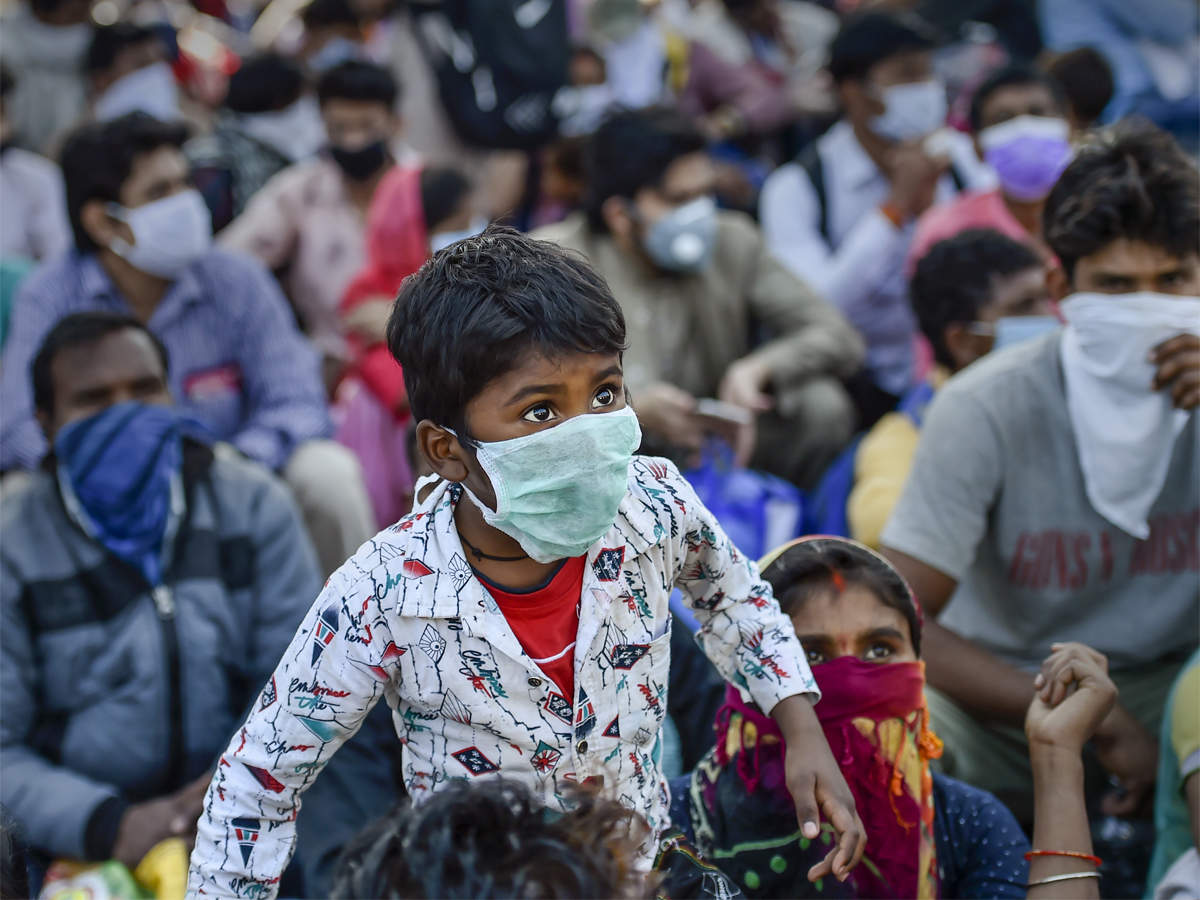Ever since the lockdown began, stories of migrant workers have haunted the country. These stories of suffering and hardship have become the face of the coronavirus disease (Covid-19) in India’s megacities. There is an eerie similarity to many of them, highlighting an unequal society that has caused a humanitarian crisis to erupt during an unprecedented health crisis.
Earlier in the lockdown, one of us noticed two children who lived on the construction site next door. They said nothing and asked for nothing, but there was hunger and curiosity in their eyes. They were the children of Ranju, a migrant worker from Bihar, who worked at the construction site. The pandemic had brought work to a standstill for her and 15 other Bihari workers — no wages, little food, and no cooking gas. An economic package has since been laid out. Yet, labour distress continues.
Why did the migrant workers make the punishing journey from big cities back to the nondescript towns and villages of largely Bihar, and in Uttar Pradesh (UP)? The following narratives from Poorvanchal (eastern UP and Bihar) prove the need for a nuanced understanding of the precarity and anxieties of the migrant workforce and the need for State policies that take this into account. The two states account for 37% of the country’s inter-state migrants whose lives and livelihoods are now uncertain, at least for the near future. We spoke to dozens of workers and community leaders to understand their anxieties and experiences and policymakers to understand their responses.
Migrant workers across the country had similar worries. The absence of basic amenities, the inability to feed their children without ration cards of the particular geography they were locked down in, and the lack of a security net to protect themselves from Covid-19 made them desperate. Worse still, the persistent fear of eviction played on their minds through the day, while mosquitoes bit them through the night. There was no spare money to purchase soaps, sanitisers, or the most essential product of the times — masks. Their economic insecurities persist despite government action in recent weeks.
Take some examples from Sitamarhi and Madhubani, Bihar. Rajesh worked at a construction site; Rajkishore Ram, Fenkan Raut, Manoj Manjhi, and Roshan Ram were labourers in a shoe factory, and Subhash Sah was a fabricator in another factory. None of them received their wages. The situation was worse for seasonal migrants who oscillated between their home and the destination states. Amar Singh, an agricultural worker in Gorakhpur, who doubles up as a painter in Delhi, travelled 900 kilometres on a motorcycle, only for his village to chase him away. Those arriving from the city were reported to the police and the pradhan, the village chief.
In Riwilganj, Bihar, the quarantine centre in the Simariya School provided respite to those who had returned. Food was provided thrice a day. A mosquito net, a towel, and bathing items were also given. But it was life beyond the quarantine that worried them — for no one knew where they would find work.
Their fears are for the immediate and long-term. Estimates of unemployment from the Centre for Monitoring the Indian Economy exhibit a dire situation. Bihar has had one of the highest rates of unemployment in March and April. While the average unemployment rate for the country was 23.5% in April, Bihar’s unemployment figure was as high as 46.6%. Uttar Pradesh is relatively better, with 21.5% unemployment rate in April.
Many of these workers escaped the serfdom in villages and flocked to cities only to be forced to restart work in villages, in farms and brick kilns, now that the pandemic rages on. The Mahatma Gandhi National Rural Employment Guarantee Scheme (MGNREGS) is now the bulwark for rural employment. In April, nearly 856,773 households demanded employment in Bihar. Of this, only 73% of households could get work. Of the 1,113,644 households in UP that demanded work through MGNREGS in April, only 67% were given work. With hundreds of thousands likely to be added to the workforce in Bihar and Uttar Pradesh, the demand for MGNREGS is expected to see a sharp rise. Generating work and ensuring regular payments will be a challenge. Bihar has a built-in disadvantage due to extensive landlessness — 80% of rural migrants are either landless or have less than one acre of land.
Yet, despite precarious work in cities, no secure wages, and little social support, India’s poorest workers have acted with restraint, still following, within their constraints, norms of social distancing.
Pandemics may have historically offered opportunities for labour to bargain for higher wages and better conditions. In India, the pressures from maliks (bosses), the pervasive informalism of new economy jobs that lead to no recognition for labour, and the urban middle-class’s assertions for exclusion of the urban poor are part of a larger problem. Opportunities are difficult in conditions of inequalities and assertions of power. India must do better, starting with inclusive urbanism and policy reforms premised on an ethic of labour care.
Take some examples from Sitamarhi and Madhubani, Bihar. Rajesh worked at a construction site; Rajkishore Ram, Fenkan Raut, Manoj Manjhi, and Roshan Ram were labourers in a shoe factory, and Subhash Sah was a fabricator in another factory. None of them received their wages. The situation was worse for seasonal migrants who oscillated between their home and the destination states. Amar Singh, an agricultural worker in Gorakhpur, who doubles up as a painter in Delhi, travelled 900 kilometres on a motorcycle, only for his village to chase him away. Those arriving from the city were reported to the police and the pradhan, the village chief.
In Riwilganj, Bihar, the quarantine centre in the Simariya School provided respite to those who had returned. Food was provided thrice a day. A mosquito net, a towel, and bathing items were also given. But it was life beyond the quarantine that worried them — for no one knew where they would find work.
Their fears are for the immediate and long-term. Estimates of unemployment from the Centre for Monitoring the Indian Economy exhibit a dire situation. Bihar has had one of the highest rates of unemployment in March and April. While the average unemployment rate for the country was 23.5% in April, Bihar’s unemployment figure was as high as 46.6%. Uttar Pradesh is relatively better, with 21.5% unemployment rate in April.
Many of these workers escaped the serfdom in villages and flocked to cities only to be forced to restart work in villages, in farms and brick kilns, now that the pandemic rages on. The Mahatma Gandhi National Rural Employment Guarantee Scheme (MGNREGS) is now the bulwark for rural employment. In April, nearly 856,773 households demanded employment in Bihar. Of this, only 73% of households could get work. Of the 1,113,644 households in UP that demanded work through MGNREGS in April, only 67% were given work. With hundreds of thousands likely to be added to the workforce in Bihar and Uttar Pradesh, the demand for MGNREGS is expected to see a sharp rise. Generating work and ensuring regular payments will be a challenge. Bihar has a built-in disadvantage due to extensive landlessness — 80% of rural migrants are either landless or have less than one acre of land.
Yet, despite precarious work in cities, no secure wages, and little social support, India’s poorest workers have acted with restraint, still following, within their constraints, norms of social distancing.
Pandemics may have historically offered opportunities for labour to bargain for higher wages and better conditions. In India, the pressures from maliks (bosses), the pervasive informalism of new economy jobs that lead to no recognition for labour, and the urban middle-class’s assertions for exclusion of the urban poor are part of a larger problem. Opportunities are difficult in conditions of inequalities and assertions of power. India must do better, starting with inclusive urbanism and policy reforms premised on an ethic of labour care.




